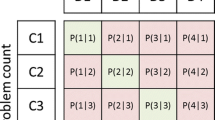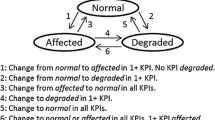Abstract
Self-Organizing Networks (SON) add automation to the Operation and Maintenance of mobile networks. Self-healing is the SON function that performs automated troubleshooting. Among other functions, self-healing performs automatic diagnosis (or root cause analysis), that is the task of identifying the most probable fault causes in problematic cells. For training the automatic diagnosis functionality based on support-decision systems, supervised learning algorithms usually extract the knowledge from a training set made up from solved troubleshooting cases. However, the lack of these sets of real solved cases is the bottleneck in the design of realistic diagnosis systems. In this paper, the properties of such troubleshooting cases and training sets are studied. Subsequently, a method based on model fitting is proposed to extract a statistical model that can be used to generate vectors that emulate the network behavior in the presence of faults. These emulated vectors can then be used to evaluate novel diagnosis systems. In order to evaluate the feasibility of the proposed approach, an LTE fault dataset has been modeled, based on both the analysis of real cases collected over two months and a network simulator. In addition, the obtained baseline model can be very useful for the research community in the area of automatic diagnosis.









Similar content being viewed by others
Abbreviations
- 3GPP:
-
3rd Generation Partnership Project
- CQI:
-
Channel Quality Indicator
- DI:
-
Degraded Interval
- DL:
-
Downlink
- EMD:
-
Entropy Minimization Discretization
- eNodeB:
-
E-UTRAN Node B
- ERAB:
-
E-UTRAN Radio Access Bearer
- E-UTRAN:
-
Evolved Terrestrial Radio Access Network
- FLC:
-
Fuzzy Logic Controller
- IRAT:
-
Inter-Radio Access Technology
- KB:
-
Knowledge Base
- KBS:
-
Knowledge Based Systems
- KPI:
-
Key Performance Indicator
- K-S:
-
Kolmogorov–Smirnov
- LTE:
-
Long Term Evolution
- NGMN:
-
Next Generation Mobile Networks
- PDF:
-
Probability Distribution Function
- PI:
-
Performance Indicator
- ROP:
-
Report Output Period
- RSRP:
-
Reference Signal Received Power
- RSRQ:
-
Reference Signal Received Quality
- RSSI:
-
Received Signal Strength Indicator
- SINR:
-
Signal to Interference plus Noise Ratio
- SON:
-
Self-Organizing Networks
- UE:
-
User Equipment
- UL:
-
Uplink
References
NGMN.: Use Cases Related to Self-Organising Network, Overall Description. Next Generation Mobile Networks Alliance (NGMN), http://www.ngmn.org, April (2007)
3GPP.: Telecommunication management; Self-Organizing Networks (SON); Concepts and requirements. 3rd Generation Partnership Project, TS 32.500 edition, September (2012)
Univerself. Univerself project. http://www.univerself-project.eu/ (2012)
Bennacer, L., Ciavaglia, L., Chibani, A., Amirat, Y. and Mellouk, A.: Optimization of fault diagnosis based on the combination of bayesian networks and case-based reasoning. In: IEEE Network Operations and Management Symposium (NOMS), April (2012)
Hounkonnou, C., Fabre, E.: Empowering self-diagnosis with self-modeling. In: 8th International Conference Network and Service Management (CNSM), and 2012 Workshop on Systems Virtualization Management (SVM), October (2012)
COMMUNE.: COMMUNE (COgnitive network ManageMent under UNcErtainty) (2012)
COMMUNE.: Specification of knowledge-based reasoning algorithms, Deliverable 4.1 (2012)
Szilagyi, P., Novaczki, S.: An automatic detection and diagnosis framework for mobile communication systems. IEEE Trans. Netw. Serv. Manag. 9(2), 184–197 (2012)
Barco, R., Díez, L., Wille, V., Lázaro, P.: Automatic diagnosis of mobile communication networks under imprecise parameters. Expert Syst. Appl. 36(1), 489–500 (2009)
Khatib, E.J., Barco, R., Gómez-Andrades, A., Serrano, I.: Diagnosis based on genetic fuzzy algorithms for LTE Self-Healing. IEEE Trans. Veh. Technol. 65(3), 1639–1651 (2015)
Fayyad, U., Piatetsky-Shapiro, G., Smyth, P.: From data mining to knowledge discovery in databases. AI magazine 17(3), 37–54 (2003)
Gómez-Andrades, A., Muñoz, P., Khatib, E.J., de-la Bandera, I., Serrano, I., Barco, R.: Methodology for the design and evaluation of self-healing LTE networks. IEEE Trans. Veh. Technol. (2015)
Lee, C-C.: Fuzzy logic in control systems: fuzzy logic controller. IEEE Trans. I. Syst. Man Cybern. 20(2), 419–435 (1990)
Muñoz, P., Barco, R., Serrano, I., Gómez-Andrades, A.: Correlation-based time-series analysis for cell degradation detection in son. IEEE Commun. Lett. 20(2), 396–399 (2016)
Khatib, E.J., Barco, R., Serrano, I., Muñoz, P.: LTE performance data reduction for knowledge acquisition. Globecom Workshops (GC Wkshps) 2014, 270–274 (2014)
Massey Jr., F.J.: The Kolmogorov–Smirnov test for goodness of fit. J. Am. Stat. Assoc. 46(253), 68–78 (1951)
Khatib, E.J., Barco, R., Gómez-Andrades, A., Muñoz, P., Serrano, I.: Data mining for fuzzy diagnosis systems in LTE networks. Expert Syst. Appl. 42(21), 7549–7559 (2015)
Fayyad, U., Irani, K.B.: Multi-interval discretization of continuous valued attributes for classification learning. In: Proceedings of International Joint Conference on Artificial Intelligence, pp. 1022–1027, August (1993)
Wang, L.-X., Mendel, J.M.: Generating fuzzy rules by learning from examples. IEEE Trans. Syst. Man Cybern. 22(6), 1414–1427 (1992)
Ciocarlie, G.F., Lindqvist, U., Novczki, S. and Sanneck, H.: Detecting anomalies in cellular networks using an ensemble method. In Proceedings of the 9th International Conference on Network and Service Management (CNSM 2013), pp. 171–174, Oct (2013)
Acknowledgements
This work has been partially funded by Optimi-Ericsson, Junta de Andalucía (Consejería de Ciencia, Innovación y Empresa, Agencia IDEA, ref. 59288 and Proyecto de Investigación de Excelencia P12-TIC-2905) and ERDF.
Author information
Authors and Affiliations
Corresponding author
Appendices
Appendix 1: Model of the Real Dataset
See Tables 11, 12, 13, 14, 15, 16, 17, 18, 19, 20, 21, 22 and 23.
Appendix 2: Model of the Simulated Dataset
See Tables 24, 25, 26, 27, 28, 29 and 30.
Rights and permissions
About this article
Cite this article
Khatib, E.J., Gómez-Andrades, A., Serrano, I. et al. Modelling LTE Solved Troubleshooting Cases. J Netw Syst Manage 26, 23–50 (2018). https://doi.org/10.1007/s10922-017-9406-3
Received:
Revised:
Accepted:
Published:
Issue Date:
DOI: https://doi.org/10.1007/s10922-017-9406-3




